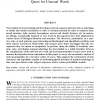55 search results - page 6 / 11 » Computing distribution of scale independent motifs in biolog... |
BMCBI
2008
13 years 7 months ago
2008
Background: Amino acid sequence probability distributions, or profiles, have been used successfully to predict secondary structure and local structure in proteins. Profile models ...
BMCBI
2006
13 years 7 months ago
2006
Background: MannDB was created to meet a need for rapid, comprehensive automated protein sequence analyses to support selection of proteins suitable as targets for driving the dev...
RECOMB
2002
Springer
14 years 7 months ago
2002
Springer
The problem of characterizing and detecting recurrent sequence patterns such as substrings or motifs and related associations or rules is variously pursued in order to compress da...
JCB
2007
13 years 7 months ago
2007
Long-range correlations in genomic base composition are a ubiquitous statistical feature among many eukaryotic genomes. In this article, these correlations are shown to substantia...
BMCBI
2010
13 years 7 months ago
2010
Background: The classification of protein sequences using string algorithms provides valuable insights for protein function prediction. Several methods, based on a variety of diff...

